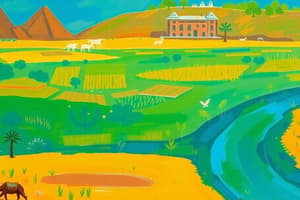Podcast
Questions and Answers
What geographical feature contributed to the protection of the Egyptian civilization from invaders?
What geographical feature contributed to the protection of the Egyptian civilization from invaders?
- The Nile River
- The Sahara Desert (correct)
- The Red Sea (correct)
- The Mediterranean Sea
Who is credited with uniting Upper Egypt and Lower Egypt around 3200 BCE?
Who is credited with uniting Upper Egypt and Lower Egypt around 3200 BCE?
- Tutankhamun
- King Menes (correct)
- Herodotus
- Cleopatra
What was the primary benefit of the annual flooding of the Nile River?
What was the primary benefit of the annual flooding of the Nile River?
- Migration of plant species
- Deposit of fertile alluvium (correct)
- Increased rainfall
- Creation of fish ponds
What material did ancient Egyptians initially use to construct their houses?
What material did ancient Egyptians initially use to construct their houses?
According to the social hierarchy in ancient Egypt, which group held the highest social standing after the pharaoh?
According to the social hierarchy in ancient Egypt, which group held the highest social standing after the pharaoh?
What staple food was primarily consumed by ancient Egyptians?
What staple food was primarily consumed by ancient Egyptians?
What role did slaves primarily hold in ancient Egyptian society?
What role did slaves primarily hold in ancient Egyptian society?
Which of the following was a major agricultural factor that contributed to the rise of the Egyptian civilization?
Which of the following was a major agricultural factor that contributed to the rise of the Egyptian civilization?
What was the purpose of the Egyptian solar calendar?
What was the purpose of the Egyptian solar calendar?
Which script was primarily used by priests in ancient Egypt?
Which script was primarily used by priests in ancient Egypt?
What material did Egyptians use for writing that was superior to clay tablets?
What material did Egyptians use for writing that was superior to clay tablets?
How did the Egyptians initially measure time during the day and night?
How did the Egyptians initially measure time during the day and night?
What significant contribution did ancient Egyptians make in the field of medicine?
What significant contribution did ancient Egyptians make in the field of medicine?
Which of the following best describes the Egyptian counting system?
Which of the following best describes the Egyptian counting system?
What led to the decline of the Egyptian civilization after the reign of Ramesses II?
What led to the decline of the Egyptian civilization after the reign of Ramesses II?
What was the role of High Priests of Amun during the decline of Egyptian civilization?
What was the role of High Priests of Amun during the decline of Egyptian civilization?
Which of the following fields did the ancient Egyptians NOT significantly contribute to?
Which of the following fields did the ancient Egyptians NOT significantly contribute to?
What key invention related to timekeeping is attributed to ancient Egyptians?
What key invention related to timekeeping is attributed to ancient Egyptians?
What was the primary agricultural concern for the Egyptians during the flooding of the Nile?
What was the primary agricultural concern for the Egyptians during the flooding of the Nile?
Which of the following materials was NOT primarily used by ancient Egyptians for clothing?
Which of the following materials was NOT primarily used by ancient Egyptians for clothing?
What was one of the key features that characterized Egyptian religious beliefs?
What was one of the key features that characterized Egyptian religious beliefs?
What significant development in architecture can be attributed to ancient Egyptians?
What significant development in architecture can be attributed to ancient Egyptians?
Which crop was NOT commonly grown in ancient Egypt?
Which crop was NOT commonly grown in ancient Egypt?
What animal did NOT serve a domestic purpose in ancient Egyptian society?
What animal did NOT serve a domestic purpose in ancient Egyptian society?
How did the Egyptians primarily transport goods along the Nile?
How did the Egyptians primarily transport goods along the Nile?
What was one of the specialized crafts practiced by the ancient Egyptians?
What was one of the specialized crafts practiced by the ancient Egyptians?
What was the fate of bodies in ancient Egyptian burial practices?
What was the fate of bodies in ancient Egyptian burial practices?
Which method was NOT used for irrigation by ancient Egyptians?
Which method was NOT used for irrigation by ancient Egyptians?
Which of the following materials was primarily used to create decorative objects in ancient Egypt?
Which of the following materials was primarily used to create decorative objects in ancient Egypt?
What was one of the primary reasons for ancient Egyptians engaging in trade?
What was one of the primary reasons for ancient Egyptians engaging in trade?
What characteristic defines the Great Sphinx in relation to its construction?
What characteristic defines the Great Sphinx in relation to its construction?
What was a common purpose of Egyptian temples?
What was a common purpose of Egyptian temples?
Flashcards are hidden until you start studying
Study Notes
Egyptian Civilisation Overview
- Developed over 4,000 years ago along the Nile River.
- Protected from invaders by the Red Sea to the east and Sahara Desert to the west.
- Enjoyed nearly 2,000 years of uninterrupted existence, the longest among known civilisations.
Importance of the Nile
- Egypt receives minimal rainfall; most land is desert.
- Annual flooding of the Nile deposited fertile alluvium, enabling agriculture.
- Greek historian Herodotus referred to Egypt as the “gift of the Nile.”
Historical Beginnings
- By the 4th century BCE, Egypt consisted of Upper and Lower regions.
- King Menes unified these regions around 3200 BCE, marking the rise of Egyptian civilisation.
- Last pharaoh, Cleopatra, ruled until Egypt's absorption into the Roman Empire in 30 BCE.
Social Structure
- Pharaohs deemed human gods; their edicts considered divine law.
- Nobility, priests, and scribes held high social status, followed by peasants and laborers.
- Slavery prevalent; slaves primarily captured in war, worked estates, and mines.
Housing and Daily Life
- Early houses constructed from papyrus and mud; later made from sun-dried mud bricks.
- Common dwellings were one-storey and flat-roofed; wealthier homes included gardens and ponds.
Food and Dress
- Staple diet consisted of bread and beer, supplemented by meat, fish, vegetables, and fruits.
- Clothing made from flax, resulting in fine linen; both men and women wore jewellery and cosmetics.
Agriculture and Economy
- Nile's seasonal flooding critical for agriculture; farmers learned to build dams and canals.
- Key crops included barley, emmer, millet, and fruits like dates and figs.
- Domesticated animals included cows, pigs, and dogs; used oxen for plowing.
Crafts and Technologies
- Pottery, glass-making, and carpentry were developed crafts; skilled furniture-making documented.
- Metalworking skills learned from the Hyksos; gold used for decorative items.
Religion and Beliefs
- Worship centered around nature deities; notable gods included Ra, Thoth, and Osiris.
- Animals like cats and jackals were considered sacred.
Burial Practices
- Embalming for mummification indicated belief in the afterlife; personal items buried with the dead.
- Pharaohs interred in elaborately constructed pyramids, including those at Giza.
Transportation and Trade
- The Nile served as a major transport route; boats designed for river and sea trade.
- Camel caravans facilitated overland trade with regions such as Mesopotamia.
Trade Routes and Commodities
- Trade routes included the Nile, Red Sea, and Mediterranean, exchanging goods like copper and tin.
- Egyptian exports consisted of gold, linen, and papyrus.
Architecture and Art
- Pyramids exemplified ancient Egyptian engineering; built with massive stone blocks.
- Tombs adorned with scenes depicting daily life and religious rituals.
Writing System
- Hieroglyphics, an early pictorial script, evolved later into hieratic and demotic scripts.
- Papyrus was the primary writing material; the word "paper" is derived from papyrus.
Achievements and Innovations
- Invented a solar calendar of 365 days; facilitated agricultural planning.
- Developed mathematics and geometry necessary for construction and land measurement.
- Accomplishments in astronomy helped guide agricultural practices.
- First water clocks devised to measure time; influenced future timekeeping.
Medicine and Healthcare
- Egyptian medicine advanced with knowledge gained from mummification; skilled in anatomy and surgery.
Decline of Egyptian Civilisation
- The reign of Pharaoh Ramesses II marked a peak in power but led to prolonged warfare with the Hittites.
- Internal leadership shifts diminished pharaoh's authority, with power shifting to the High Priests by 1070 BCE.
- Successive invasions by Nubians, Assyrians, Persians, and Greeks weakened the state.
- Egypt became a Roman province in 30 BCE, marking the end of its sovereignty.
Studying That Suits You
Use AI to generate personalized quizzes and flashcards to suit your learning preferences.




